 |
 |
|
 |
Spring-like temperatures bring springtime problems—flooding |
 |
 |
 |
|
Fast rising waters caused by ice jams on the Root River ripped away about 1,000 feet of the shoulder on Hwy 16 west of Hokah in Houston County. Photo by Dave Redig |
Temperatures in southeastern Minnesota reached into the 50s, rains came and rivers such as the Root began to spread over their banks.
Springime? Wrong, it's February—early February.
The unseasonable run of warm weather brought relief from temperatures that had dropped below zero, but there was a price to pay. Flooding. Ice jams on the Root River caused back-ups, sending water over fields and highways near Hokah in Houston County.
Flooding was most severe on Hwy 16 near Hokah, where the fast-rising river tore out the shoulder on a 1,000-foot section of the highway. Water on that section of the highway rose to more than a foot deep, forcing Rochester/District 6 officials to close the road from 6 p.m. on Feb. 6 until 10 a.m. the following day.
Dave Redig, maintenance superintendent at Rochester, said crews from the Houston, Caledonia and La Crescent truck stations set up barricades, cleaned out ice-jammed culverts and plowed off huge slabs of ice that the river carried onto the roadway.
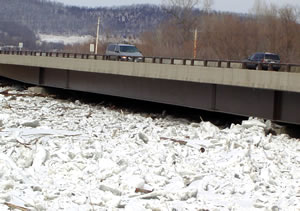 |
Chunks of ice on the Root River reached the girders of the Hwy 16 bridge near Hokah. Photo by Dave Redig |
Greg Husmann, subarea supervisor at La Crescent, manned one of the traffic closure spots Sunday night while maintenance crews worked to clear the highways of snow that followed the rain storm. The State Patrol, local law enforcement agencies and the Hokah Fire Department also assisted with traffic control.
The location is a frequent one for floods, but not usually this early in the year. The sudden warm-up, a 10-inch snowfall and as much as half an inch of rain, Redig said, were factors in the river’s sudden rise.
The river ice jam, he added, started at the Hwy 26 bridge north of Hokah near La Crescent where a tree or other debris blocked the Root’s eastward flow to the Mississippi River.
Ice slabs, he said, nearly reached the girders of both the Hwy 16 and Hwy 26 bridges.
Redig said the damaged shoulder on Hwy 16 will be barricaded until spring when repairs can be made.
“We’ll have to rebuild it from the ground up,” he said.
By Craig Wilkins
|
back

|
 |
Bemidji gets a little help—and lots of salt—from its friends |
 |
 |
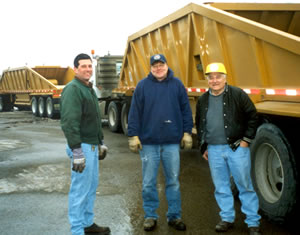 |
|
Mission accomplished. John Adam, a transportation specialist at Park Rapids (at left) relaxes during a rare, sunny day with Greg Kotzenmacher and Marvin Woehler before they return their empty dump trucks to Willmar. Photo by Karen Bedeau |
It’s like a neighbor loaning you an egg or a cup of sugar, but on a bigger scale. Ninety-two tons of de-icing salt bigger.
The neighborly loans came from the Willmar and Duluth districts to the Bemidji District, hard hit by continuing cycles of rain, snow and deep cold that started in late November and continued well into January.
Bemidji’s intense efforts to deal with the storms drew its salt supply way down. Late shipments from suppliers didn’t help either.
Fortunately, the Duluth District had enough salt stockpiled at Virginia and easily accessible at Duluth to lend Bemidji a hand.
Maintenance crews at places like Willmar and Hutchinson experienced a relatively balmy early winter, enabling them to contribute as well.
In early February, workers from Virginia trucked 24 tons of salt to the Northome Truck Station while crews from Willmar hauled 68 tons of salt up Hwy 71 to the truck station at Park Rapids.
“When our call for help went out, we got responses in a hurry,” said Dave Dalager, maintenance superintendent at Crookston.
“We mixed that salt with sand to stretch it out and to provide some grit for traction and some salt to melt the ice,” Dalager said.
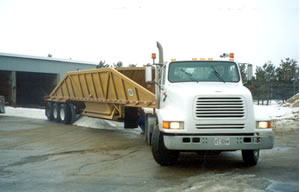 |
Marvin Woehler, a transportation generalist at Willmar, unloads a shipment of salt at the Park Rapids Truck Station’s storage shed. Photo by Karen Bedeau |
No storms followed the deliveries, however, and Dalager said maintenance crews had a well-deserved break from the weather.
The cycles of rain, deep cold and snow had taxed maintenance workers and supervisors who had worked long hours combating the ice and snow, sometimes sleeping in their truck stations between shifts.
“Our roads were so slippery we threw everything at them that we could—serrated cutting edges, rotating carbide discs and a lot of salt,” Dalager said. “Now they’re looking pretty good.”
Dalager said the most difficult conditions existed along a tree-lined stretch of Hwy 11 near Baudette, which received virtually no melting benefit from the sun because of the ample shade.
In addition to frequent icing conditions, Dalager said the district had received about 30 inches of snow by mid-February. Those conditions, he said, will result in the district spending about $1.1 million for salt, double the cost in previous years.
Rebidding a new contract for salt, he said, resulted in a cost increase of about $10 per ton, partly attributable to shippers’ experiencing higher than normal fuel prices.
While workers from Willmar and Virginia were delivering salt to the Bemidji District, Greg Pierzina, Range Area maintenance supervisor, said Jim Fester was heading back to the Windom Maintenance Area after spending two weeks in District 1.
Fester, a transportation generalist, took Windom’s heavy duty SnoGo to blow heavy accumulations of snow from guard rails, bridges and sight corners left by heavy storms that dropped about 65 inches of snow in the Arrowhead Region.
“In December and January,” Pierzina said, “it seemed like it never stopped snowing.”
Pierzina said Fester trained four employees at Virginia to operate the high-powered SnoGo as well as driving it himself, sharing his expertise as they worked.
“We’re supposed to share our resources,” he said, “and we did.”
By Craig Wilkins
|
back

|
 |
Mn/DOT investment pays off in congestion relief |
 |
 |
Drivers in the northwestern part of the Twin Cities are traveling easier these days, thanks to a just-completed highway project.
Mn/DOT recently collected traffic count data on Interstate 94 between Hwy 252 and I-494 and learned that a large Metro District project completed last fall has led to impressive decreases in congestion—although traffic itself has actually increased.
“Transportation improvement is one of the most important services we provide the citizens of our state,” said Gov. Tim Pawlenty. “This data shows that the work we’ve done so far, and plan to do, will add value to our economy and quality of life. This is an excellent example of how investment in our transportation system pays off.”
The project added a third lane on I-94 from Hwy 152 to I-494, through Brooklyn Center, Brooklyn Park and Maple Grove. Construction on the seven-mile, $70 million project began in June 2002 and was completed in November 2004. The funding was provided by the 2000 Minnesota Legislature, which appropriated $459 million for interregional corridor and bottleneck reduction projects.
Congestion decreased by 96 percent between Weaver Lake Road and Hwy 252 between January 2001 and January 2005, according to Mn/DOT data.
Mn/DOT defines congestion as traffic flowing on the freeway at speeds less than 45 miles per hour. On I-94, this means travelers went from facing hours of traffic congestion during the peak rush hour periods (6 a.m. to 9 a.m. and 3 p.m. to 7 p.m.) to spending almost no time in congestion. During that time, vehicle miles traveled on that stretch of roadway increased 13 percent.
The department’s annual Twin Cities Metro Area congestion report also found that, in 2004, travel got a little easier for many Metro drivers.
In the report, the Regional Transportation Management Center staff found that, across the Twin Cities Metro Area, congestion decreased from 22.9 percent of the total metro roadway mileage in 2003 to 21.6 percent in 2004. Mn/DOT credits the congestion reduction to the completion of several large projects on I-94, I-494 and 35E.
The Pawlenty-Molnau administration plans to continue this trend of congestion relief with a 10-year, $7.15 billion transportation investment program that will accelerate construction of dozens of major highway and transit projects without raising taxes. It is the largest transportation investment program ever proposed by a Minnesota governor.
“We will continue to work on the problem areas in the coming years, and can build even more if the governor’s investment package is passed by the Legislature,” said Lt. Gov./Commissioner Carol Molnau.
“We have moved a number of projects like this one ahead and hope to have similar results on I-494 on the west side, on Hwy 169 and on other congested roadways in the Twin Cities Metro Area, and around the state. We want to ensure that traffic can flow as freely as possible, and that we are investing taxpayer dollars wisely,” she said.
The I-94 roadway through the northwestern suburbs is one of the more heavily traveled in the Twin Cities Metro area, carrying from 95,000 to 100,000 cars a day. Prior to the project, that area had a significant congestion problem due to the reduction of lanes from three to two on westbound I-94 near Hwy 152 and on eastbound I-94 near County Road 61. As part of the project, Mn/DOT and the city of Maple Grove reconstructed the interchange at CR 61 and Mn/DOT replaced bridges over Hwy 81 and West Broadway Avenue to accommodate the additional lanes.
The 2004 Metro Freeway Congestion report is available at: http://www.dot.state.mn.us/trafficeng/otepubl/CongestionReport-2004.pdf.
By Kevin Gutknecht
|
back

|
 |
Productivity and Cost Management effort moves forward |
 |
 |
Mn/DOT managers this week received the first of several sets of recommendations to come from the Productivity and Cost Management Task Force. The initiative began in January 2004 to determine the true cost of delivering products and services and predict how much program the department can deliver with available staff.
So, how many employees does it require to deliver the program?
“It depends,” said Dick Stehr, director, Engineering Services Division. “Even if the total program size remains constant each year, the project mix can change, which can require a different number of full time equivalents to deliver the program. For example, more new bridges and fewer overlay projects would require more program delivery effort.”
Answering questions like this is the impetus behind the Productivity and Cost Management effort. By using the same process for collecting data from both in-house and consultant designs, Mn/DOT will be able to compare the costs of the two methods.
Among task force recommendations are improving use of Activity Codes and PPMS to better track in-house delivery costs and consultant delivery costs, using the same project work types for both and collecting all costs associated with plan delivery, including project scoping, preliminary design and detail design.
In future efforts, the same data will be gathered and analyzed on activities involving environmental documentation, construction limits, right of way processing, letting, materials inspection and field inspection. Right of way and letting will be the focus over the next six months.
The department’s division directors approved the recommendations last week after review by Mn/DOT district engineers and office directors.
“One of our objectives is to help Mn/DOT managers effectively make decisions using accurate data on how much it costs to deliver Mn/DOT’s products and services," said Mary Prescott, a member of the task force and Division Business Manager for the Engineering Services and Operations, Safety and Technology divisions.
“Another objective is to develop an overhead rate for program delivery in addition to maintenance activities. For workload leveling, the data helps managers predict how much program we can deliver with our own staff,” said Prescott.
“Work should be done as cost-effectively as possible,” said Stehr. “We should use more consultants in areas where they can perform as cost effectively as Mn/DOT’s work force, while limiting their use in areas where they cost a lot more.”
Stehr congratulated task force members for dealing successfully with some very difficult and complex issues.
“This work will pave the way to answering key questions regarding Mn/DOT’s businesses that we have not been able to answer in the past,” he said.
Some task force recommendations have been implemented, while others are in progress or nearing completion. More information, including a timeline and schedule, is posted on the Office of Finance Web site.
Mukhtar Thakur, director of the Technical Support office, chairs the task force. In addition to Thakur and Prescott, task force members include: Lee Berget, Betsy Brown, Jim Dibble, Glen Ellis, Joe McKinnon, Bob McPartlin, Larry Moser, Jim Povich, Val Svensson, Dick Swanson, Nan Swift and Jim Weingartz.
By Jeanne Aamodt
|
back

|
 |
FHWA-conducted training raises civil rights law awareness for Mn/DOT leaders |
 |
 |
 |
|
Johnnie Burns, an EEO/Contract Management office staff member, conducts a training session on the DBE certification program. Photo by David Gonzalez |
In order to broaden their understanding of civil rights laws and their effect on Mn/DOT operations, staff from Mn/DOT and other agencies participated in training seminars conducted by the Federal Highway Administration Feb. 7-10 in St. Paul.
Participants explored federal and state laws that govern efforts such as the Disadvantaged Business Enterprise program, equal employment opportunity goals, contract compliance and resolving conflicts in contract award procedures.
Staff from Mn/DOT's Office of EEO/Contract Management worked with the FHWA's St. Paul office to arrange the training program.
Trainers from FHWA regional offices traced the history of key pieces of civil rights law such as Title VI and Title VII of the Civil Rights Act of 1964 and the Americans with Disabilities Act of 1990. Lt. Gov./Commissioner Carol Molnau and members of her staff, other Mn/DOT managers and employees, as well as representatives from the Metropolitan Council and the Metropolitan Airports Commission, attended the training sessions.
Executive sessions were held in the Transportation Building; general sessions were held at the Harriet Island Pavilion in St. Paul.
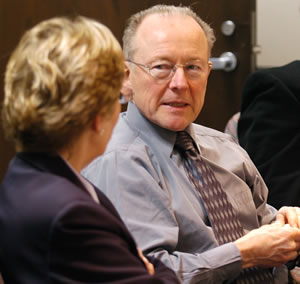 |
Betsy Brown, Metro Division administrative manager, and Dick Stehr, Engineering Services Division director, confer during a training session. Photo by David Gonzalez |
“We were pleased that we were able to gather civil rights experts from around the country so they could share their expertise here,” said Peter Kiernan, a civil rights official with the FHWA’s Minnesota Division. “I believe the training helped people from Mn/DOT and the other agencies gain awareness of the laws and regulations that affect us as well as the complexity and scope of the federal civil rights programs.”
The training, he said, used lectures, discussions and some role-playing to help the participants grasp the complex set of laws related to civil rights and their enforcement.
Terry Ward, District 6’s project manager for rebuilding Hwy 52 in Rochester, said the training will help him and his staff apply the knowledge they gained to design-build and other innovative project delivery methods.
“In our traditional design-bid-build process,” he said, “the contractor’s DBE status is determined shortly after letting but before execution of the contract. This is possible because all the financial aspects of the project are available at that time, including items of work and unit bid pricing.
“However, with design-build, a contractor’s DBE status is much more difficult to determine, especially a good faith effort, because the project is lump sum in nature and there are not quantities and unit prices to work with. Also, since the design is typically only 30 percent complete, the design-build team may not know what DBE firms that will be used during the project and won’t know until the final design process advances further.
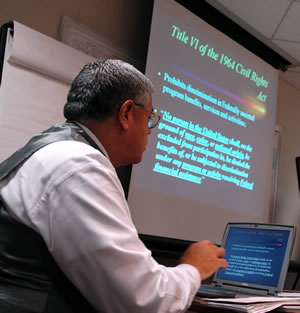 |
Peter Silva, a civil rights specialist with the FHWA office in Baltimore, outlines the origins of civil rights laws for participants. Photo by David Gonzalez |
“The training was valuable,” Ward said. “I took away a lot that we can apply to DBE goals and other civil rights issues.”
Lynnette Geschwind, Affirmative Action Office director, conducted additional training sessions that focused on the internal application of state and federal civil rights laws for administrative managers, human resources and other support staff members.
“The training was helpful,” said Teresa Elkin, training and human resources coordinator with District 4, “especially by providing awareness of issues and processes and where to go for additional resources.”
The training sessions were designed to bolster understanding of civil rights laws and regulations to enable Mn/DOT to meet FHWA guidelines and provide better assistance to other government agencies and contractors.
“The civil rights training was a great opportunity for Mn/DOT employees at various levels to learn more about what the Office of EEO/Contract Management does,” said Joanne Wagner, office director. “I believe that participants now have a more clear understanding of how vital a role these federal laws and programs play in the overall delivery of Mn/DOT's strategic objectives."
By Craig Wilkins
Mn/DOT will host AASHTO civil rights conference in 2006
Officials from the American Association of State Highway and Transportation Officials announced that Mn/DOT will host its next conference on civil rights issues in 2006.
“This is an outstanding opportunity for Minnesota to showcase our state and to highlight our commitment to civil rights,” said Kevin Gray, Finance and Administration Division director. “We’ll work hard to deliver an innovative and informative session for participants; we’re honored that AASHTO selected us to be the host state.”
Dates for the conference have not been determined.
|
|
back

|
 |
Crookston tests system that extends life of vehicle oils, hydraulic fluids |
 |
 |
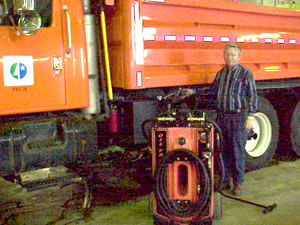 |
|
Bill Cassavant, shop supervisor at Crookston, rolls the oil cleaning and recycling system into place to service a snowplow truck. Photo by Karen Bedeau |
Bill Cassavant knows all too well the damage dirt and other friction-producing contaminants in oil and hydraulic fluids can cause: they can greatly shorten the life engines and hydraulic systems in Mn/DOT snowplow trucks and other equipment.
As the shop supervisor at District 2’s Crookston Maintenance Area, he also knows the benefits that contaminant-free oil and fluids can bring.
When Cassavant learned of a system that could clean and recycle oil and hydraulic fluids, he moved quickly to obtain one from a Fargo manufacturer by working with the Office of Maintenance Operations and Research.
The system has fiberglass filters that can trap silica or metal particles as small as two micrometers in size. The manufacturer claimed that cleaning and recycling system could, for example, remove contaminants from new motor oil and increase its performance.
Laboratory tests by an engine manufacturer showed that to be true, Cassavant said.
By removing contaminants from new oil and recycling it, Cassavant said the district can save money and extend the life of both gasoline and diesel engines by thousands of hours of use. He expects similar performance gains in hydraulic systems.
The performance of hydraulic fluids, he said, becomes even more important as Mn/DOT equipment becomes more automated and complex.
Cassavant said the system is easy to operate and takes only about 20 minutes to clean and recycle the oil in a snowplow truck.
“This system can save us thousands of gallons of oil and hydraulic fluid each year,” he said. “I believe it has the potential, for example, to double the service life of a typical diesel engine or hydraulic system and greatly reduce repair costs.”
By Craig Wilkins
|
back

|
 |
Phoenix program targets high school students for transportation careers |
 |
 |
Getting kids interested in transportation at a young age could be the key to filling critical technical and engineering positions at Mn/DOT in the future. One new program called “Phoenix ” may help do that.
Phoenix is an internal recruitment program that complements the current Seeds and Graduate Engineer programs.
“The goal of Mn/DOT’s internal recruitment programs is to interest young people in Minnesota in pursuing transportation careers in Minnesota,” said Robert Lowe, Early Recruitment & Program Development in the Office of Workforce Development.
Lowe created the Phoenix program to partner with Project Lead the Way, a national program designed to increase the number of young people interested in engineering and technology degrees. The program offers a pre-engineering curriculum to high-school juniors and seniors. There are currently five high schools in the Twin Cities Metro Area participating in PLTW.
The Phoenix program links high-potential high school students with opportunities at Mn/DOT. Candidates are nominated by their school's counselor to attend special events, such as half-day field trips to Mn/DOT locations to get a "eyes and hands-on" exposure to transportation careers. These students are then eligible to work in the summer as interns with Mn/DOT in the Metro area.
Mn/DOT kicked off the Phoenix program last week with its first student orientation session. Students will begin this summer doing real life work in an office environment at either the Central Office or Waters Edge. Seniors can also work part time during the school year.
“Our recruitment efforts and programs, such as Phoenix, Seeds and Graduate Engineer, work together to ensure a sufficient pool of highly qualified and diverse candidates for future Mn/DOT jobs,” said Eric Davis, Workforce Development acting director.
An article about Mn/DOT’s Phoenix program appeared in the Jan. 24 issue of the Pioneer Press.
By Donna Lindberg
|
back

|
 |
Engineering council honors Hiawatha LRT project |
 |
 |
 |
With the Minneapolis skyline in the background, a light rail transit train carries passengers on opening day June 26, 2004. The Hiawatha LRT recently earned a Grand Award for engineering excellence from the Minnesota chapter of the American Council of Engineering Companies. Photo by David Gonzalez
|
The Hiawatha light rail transit line in Minneapolis earned a Grand Award for engineering excellence from the Minnesota chapter of the American Council of Engineering Companies.
The award was presented to the Parsons Transportation Group/Edwards and Kelcey Joint Venture and its major subconsultant, Toltz, King, Duvall & Anderson, lead designers for the Hiawatha LRT project. Mn/DOT and its project partner, Metro Transit, also received awards for the Hiawatha LRT.
The annual award honors engineering projects based on their meeting owner/client needs, meeting a community need for social and economic development and sustainability as well as the project’s uniqueness and complexity.
Judges represented both private firms and government agencies, said David Oxley, director of the ACEC’s Minnesota chapter.
This is the 38th year the council has presented its Grand Awards.
MCEC represents design, engineering and consulting firms that work with Mn/DOT, other government agencies and private sector firms.
|
back

|
 |
|
 |



